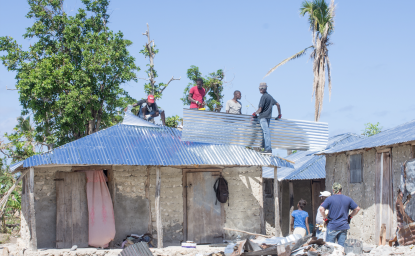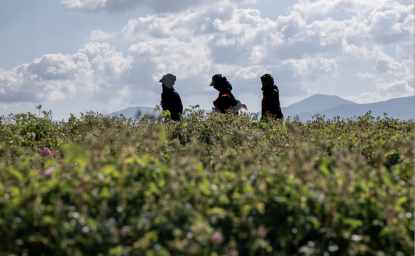Featured Book Review: Breaking the Conflict Trap: Civil War and Development Policy
Colin H. Kahl reviews the World Bank's new study of the consequences, causes, and solutions of civil war.
Colin H. Kahl reviews the World Bank's new study of the consequences, causes, and solutions of civil war.
Reviewed by Colin H. Kahl
In 1999, the World Bank Group began a research program under the direction of Paul Collier to study the economics of civil war, crime, and violence. The program produced many widely-circulated papers (e.g., Collier, 1999; Collier, 2000; Collier and Hoeffler, 2002) that form the foundation of the new book Breaking the Conflict Trap: Civil War and Development Policy by Collier et al. (2003). Although the authors draw the bulk of their conclusions regarding the consequences, causes, and solutions of civil war from statistical studies, they manage to present evidence and arguments in an easily digestible fashion. Researchers looking for detailed data and models will be disappointed (the book includes only tables, figures, and references to earlier studies), but readers seeking a compelling analysis of the implications of this research will be more than satisfied with this volume.
Conflict Traps and Neighborhood Effects
In Part I, Collier et al. contend that civil wars typically create "a persisting legacy of poverty and misery" (20). Wars directly damage critical infrastructure, investor confidence, and social capital; individuals are driven from their homes, and diseases such as HIV/AIDS and malaria thrive among military personnel and vulnerable populations. More indirectly, war undermines the economy, as money is shifted from productive investments into military budgets. Together, these effects cripple the ability of already-marginalized countries to develop, creating a "conflict trap" in which countries repeatedly fall back into civil war, despite attempts to escape.
Compounding the problem, civil wars' devastating costs are rarely contained within the afflicted country's borders. At the regional level, civil wars create destabilizing "neighborhood effects." Regional refugee crises, like those arising from recent conflicts in Central Africa, often impose large economic burdens on neighboring countries and contribute to the spread of infectious diseases like HIV/AIDS and malaria. The harmful effects of civil war ripple outwards, leading to escalating arms races, trade disruptions, and loss of investor confidence in entire regions. Globally, civil wars contribute to both the illegal drug trade (e.g., Colombia and Afghanistan) and the international HIV/AIDS pandemic (e.g., Uganda), and war-torn countries are at risk of becoming havens and recruiting grounds for international terrorist networks (e.g., Afghanistan). Breaking the Conflict Trap argues compellingly that the international community has a stake in preventing and settling civil wars, even if they occur in countries that do not appear to be strategically important.
The Causes of Civil War
In Part II, Collier et al. identify the principal drivers of civil war as low economic growth, dependence on natural resource exports, and prior civil conflicts:
[T]he key root cause of conflict is the failure of development. Countries with low, stagnant, and unequally distributed per capita incomes that have remained dependent on primary commodities for their exports face dangerously high risks of prolonged conflict. In the absence of economic development neither good political institutions, nor ethnic and religious homogeneity, nor high military spending provide significant defenses against large-scale violence. Once a country has stumbled into conflict powerful forces—the conflict trap—tend to lock it into a syndrome of further conflict (53-54).
Seeking to debunk the notion that most conflicts arise from ethnic and religious divisions, the authors argue that the relationship between ethnicity and conflict is more complicated than conventional wisdom suggests, and present evidence that countries with high levels of ethnic and religious heterogeneity are actually less likely to experience bloodshed than homogenous countries. The risks increase substantially, however, if one group holds an absolute majority over several smaller groups (which presumably fear perpetual domination), or if a society is split into two equal but polarized groups.
Policy Recommendations
Part III recommends policies that address the economic roots of civil war: Collier et al. urge the international community to use foreign aid and market access to promote economic diversification, limit corruption, strengthen political reform, and reduce excessive military spending. However, as Nicholas Stern, Senior Vice-President and Chief Economist at the World Bank, writes in the book's forward, the authors "place particular emphasis on improving the international governance of natural resources" (x). To minimize the destabilizing effects of dependence on natural resources, Collier et al. argue that policies such as emergency grants and risk mitigation mechanisms should be utilized to cushion vulnerable countries against adverse price shocks.
In addition, the authors strongly endorse actions that limit the ability of rebel groups to profit from natural resources, such as the Kimberley process for tracking diamonds, by reducing the incentive to seize resources and use them to finance conflict. Finally, the authors call on governments and corporations to endorse greater transparency and enhance international scrutiny of their natural resource revenue streams and policies; these efforts might reign in corruption and discourage rebels from exaggerating their profits from captured resources.
Collier et al. also identify other proposals to maintain peace, such as deploying credible third-party peacekeepers, and helping some demobilized troops return to normal economic activity while combining others in a newly unified national military. Once peace is established, Collier et al. argue that international aid should gradually increase to promote economic growth and more inclusive social policies, but should not necessarily encourage a fast transition to democracy, which can be destabilizing. International aid agencies should seek the appropriate mix and sequence of policies that minimize the likelihood that countries will fall back into turmoil.
Abundance vs. Scarcity
Breaking the Conflict Trap's World Bank pedigree suggests that it is likely to be influential, and we should applaud the authors for showing that civil wars are significant threats to development and international security, not just humanitarian crises or regional headaches. To the degree that it inspires increased efforts to prevent and resolve conflicts, the book will have performed a great service.
That said, Breaking the Conflict Trap is not without its problems, especially in its assessment of the causes of civil wars. The authors' conclusion that poor economic conditions and prior conflicts make countries prone to further conflict reinforces the findings of other prominent quantitative studies (e.g., Goldstone et al., 2000). More controversially, they claim that dependence on natural resources, as measured by the percentage of GDP stemming from primary commodity exports, increases the risk of civil war in two ways: first, dependence limits economic diversification, increases vulnerability to external price shocks, and contributes to corruption and other forms of bad governance, and thus increases incentives for rebellion; this could be called the "resource curse" (Ross, 1999). Second, the existence of valuable natural resources can encourage attempts by rebel organizations to secede or hijack the state as a means of controlling their revenue streams, which is sometimes called the "honey pot" effect (de Soysa, 2000). Even when seizing the honey pot is not the principal motivation, Collier et al. argue that natural resources fuel civil wars by financing rebel activities.
According to some (including at times the authors), these findings suggest that an abundance (or greater endowment) of natural resources is the problem, which is the inverse of the popular neo-Malthusian claim that scarcity drives conflict (see also Pearce, 2002). This interpretation is unpersuasive, since the data only measures levels of dependence, not abundance or scarcity, or trends towards one or the other. Moreover, even when resources are locally abundant, scarcity at the global level makes certain natural resources valuable, generating resource curses and honey pots. No one would fight over oil, diamonds, coltan, gold, copper, timber, or illegal drugs if they were not globally scarce (even if, as with diamonds or drugs, scarcity is an artifact of industry practices or government regulations). Thus, the abundance versus scarcity dichotomy is false, and Collier et al.'s work could be interpreted as broadly supporting the neo-Malthusian position (e.g., Klare, 2001; Renner, 2002).
Resources Without Differences, Greed Without Grievances
The authors' analysis is limited by their tendency to lump all natural resources together, which is problematic because natural resources have different characteristics and potential for conflict (Le Billon, 2001). Valuable minerals and timber, for example, are much more likely than agriculture to produce resource curses because governments typically own such resources or otherwise control the bulk of their revenue streams (Karl, 1997; Ross, 2001). Likewise, honey pots drive conflicts when natural resources are highly concentrated or otherwise easily seized and controlled by rebel organizations; therefore, minerals and timber are more likely to produce conflict than diffuse resources such as cropland or freshwater.
Also problematic is Collier et al.'s propensity to view greed as the principal motivation underlying natural resources' role in civil war. Although the authors are careful to emphasize that civil wars arise from a combination of greed and grievance, they do not explore the relationship between natural resources and grievances. This is a serious oversight, considering the prevalence of grievance-based arguments in the literature on eco-violence. Indeed, a significant number of case studies show that environmental degradation and economic dislocations caused by resource extraction often lead to greater support for rebel organizations (e.g., Homer-Dixon, 1999; Renner, 2002). For example, copper mining in Bougainville, Papua-New Guinea created environmental and socioeconomic problems that contributed to rebellion; the principal motivation was not to seize the honey pot but to stop or destroy it (Böge, 1992; Renner, 2002; pp. 44-45). Similarly, deforestation and its related problems, such as soil erosion and landlessness, encouraged many peasants in the Philippines to back communist guerrillas during the 1970s and 1980s; they were not driven by the desire for logging revenues, but rather by grievances arising from unsustainable logging and agricultural practices (Kahl, 2000, chap. 3).
Collier et al.'s conclusions and policy recommendations regarding natural resources are, at best, incomplete; to fill in the gaps, the authors should disaggregate natural resources and study their varying effects. In addition, the policies outlined in Breaking the Conflict Trap will be insufficient unless they also include methods to prevent or mitigate the causes and harmful side effects of resource consumption and extraction.
Bottom-Up Bias
In general, Breaking the Conflict Trap suffers from a "bottom-up" bias: the authors assume that all three major risk factors associated with civil war (poor economic conditions, natural resource dependence, and prior conflict) direct violence upwards toward the government or sideways toward other groups. Obviously, many conflicts play out this way; nevertheless, in many other situations (e.g., the former Yugoslavia, Russia, Kenya, Rwanda, and Zimbabwe), large-scale violence and civil war are initiated or exacerbated by threatened political leaders who instigate bloodshed between social groups to preserve or expand their political power (Brown, 2001; De Figueiredo and Weingast, 1999; Kahl, 1998; Kaufman, 2001; Snyder, 2000). The risk factors identified by Collier et al. could threaten the viability of a regime and thus trigger these types of top-down conflicts, but the authors largely ignore this possibility; preventing state elites from instigating conflict may require a very different mix of policies. Moreover, some rebellions may be justifiable responses to repressive regimes; in this context, policies designed to suppress potential rebellions may strengthen the hands of ruthless leaders, leading to greater hardship over the long run.
Despite these shortcomings, Breaking the Conflict Trap is essential reading: the book addresses the most important security challenge of the post-Cold War era with a powerful combination of data, theory, and policy recommendations. The earlier studies upon which the book is based have already gained a large audience in policy-making and academic circles. This influence will certainly broaden now that the findings have been brought together and lucidly presented in this volume.
Click Here for References
Colin H. Kahl is an assistant professor in the Department of Political Science at the University of Minnesota and a consultant for the Political Instability Task Force. His current research focuses on a broad range of international security issues, including civil and ethnic wars.
Click here for the entire Spring 2004 issue of PECS.

The Environmental Change and Security Program (ECSP) explores the connections between environmental change, health, and population dynamics and their links to conflict, human insecurity, and foreign policy. Read more



